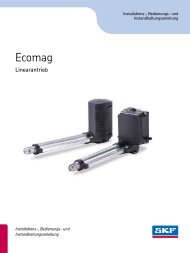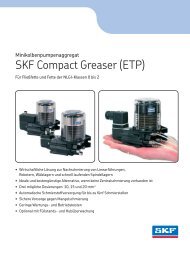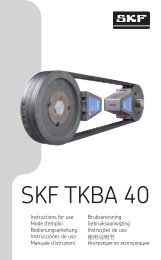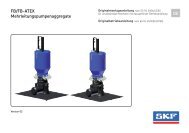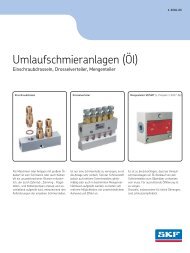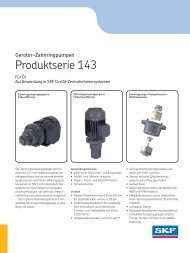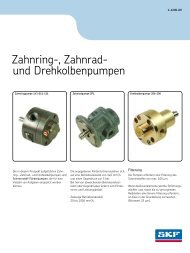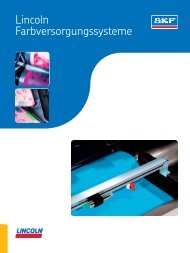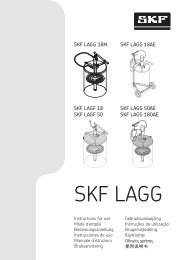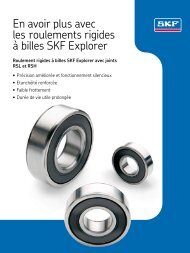SKF Timing Belt Kits - SKF.com
SKF Timing Belt Kits - SKF.com
SKF Timing Belt Kits - SKF.com
You also want an ePaper? Increase the reach of your titles
YUMPU automatically turns print PDFs into web optimized ePapers that Google loves.
Troubleshooting and failure analysis<br />
Failure during vehicle operation is a serious matter. To resolve belt failure, determine cause of failure before replacing<br />
with a new belt. This will maximize the capability of the belt and extend its life.<br />
Also replace timing belt with the same size and tooth profile to avoid engine damage.<br />
The following is an introduction to belt failure main causes.<br />
Please check the items in this table when failure occurs.<br />
For <strong>Timing</strong> <strong>Belt</strong>s<br />
Symptom/Appearance Probable cause Corrective action<br />
• Poor alignment ..................................................Adjust the alignment<br />
Abnormal side wear • Base not adequately fixed ................................Strengthen the base fixture<br />
• Bending of the pulley flange ............................Correct<br />
Abnormal wear at tooth surface where • Overload .............................................................Check for correct belt roller profile<br />
pressure is being exerted • Overstretched belt.............................................Adjust the initial tension of the belt<br />
Abnormal wear at contact point of • Overstretched belt.............................................Adjust the initial tension of the belt<br />
pulley area • Defective pulley tooth form .............................Replace with correct pulley paying special<br />
attention to the profile of the pulley tooth<br />
• Pulley diameter too small ................................Check for correct pulley<br />
Tooth damage • 6 teeth or less for T.I.M ....................................Check for correct pulley<br />
• Exertion of shock load ......................................Ensure that shock is not exerted on the belt<br />
• Overload .............................................................Change the system for proper<br />
tensioner adjustment<br />
Breaking of tensile body • Drop in elasticity or corrosion of<br />
tensile body ........................................................Check the storage condition and<br />
condition of the belt<br />
• Exertion of shock load ......................................Ensure that shock is not exerted on the belt<br />
Crack at the back side • Usage under -30°C (-22°F) ............................Raise the surrounding temperature<br />
• Pulley diameter too small ................................Check for correct pulley<br />
Thermal aging of rubber / polyurethane • Temperature of 80°C (176°F) and<br />
above at the rubber / polyurethane ...............Reduce the surrounding temperature<br />
Swelling of the rubber • Oil contamination ..............................................Use polyurethane or oil resistant rubber<br />
belt, check for seal leaks and correct<br />
• Overload .............................................................Change for proper tension<br />
Abnormal wear at pulley tooth • Overstretched belt.............................................Adjust the initial tension of the belt<br />
• Pulley life ............................................................Change to a new pulley<br />
Wear at pulley edge • Overstretched belt.............................................Change to new pulley and belt while<br />
(Tensile body can be seen underneath loosening the tension<br />
the belt)<br />
• Poor alignment ..................................................Adjust the alignment<br />
• Overstretched belt.............................................Adjust the initial tension of the belt<br />
Abnormal operation sounds • Overload .............................................................Check the system design<br />
• Pulley diameter too small ................................Check the system design<br />
• Defective pulley tooth form .............................Ensure that pulley tooth profile is correct<br />
83



